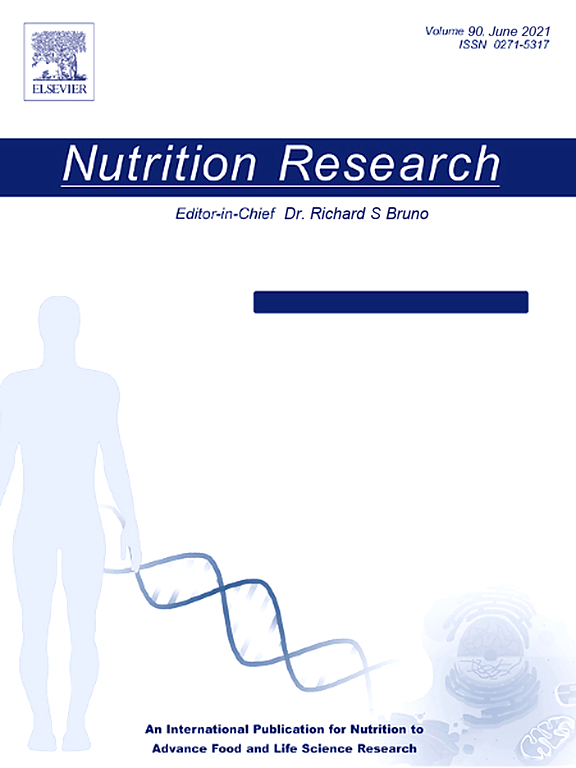美国中西部一组12个月的幼儿饮食与皮肤类胡萝卜素的关系
IF 3.1
3区 医学
Q2 NUTRITION & DIETETICS
引用次数: 0
摘要
类胡萝卜素是水果和蔬菜中的色素,食用后会在人体组织中积累。虽然横断面研究将皮肤类胡萝卜素与类胡萝卜素摄入量联系起来,但儿童时期的纵向数据有限。本研究旨在(1)描述12个月幼儿皮肤类胡萝卜素和类胡萝卜素摄入量的变化,(2)检查每个时间点类胡萝卜素和皮肤类胡萝卜素摄入量之间的横断面关系。我们假设类胡萝卜素摄入量与皮肤类胡萝卜素之间存在正相关。幼儿参加了一项为期12个月的队列研究,有3个时间点:基线(12-18个月,n = 51),中点(18-24个月,n = 46)和最终评估(24-30个月,n = 41)。用反射光谱法(Veggie MeterTM)测定皮肤类胡萝卜素。父母在每个时间点完成3次饮食回顾,以评估幼儿的摄入量。重复测量方差分析显示皮肤类胡萝卜素无显著变化;番茄[F(2,74) = 4.61, P = 0.01]、α-胡萝卜素[F(2,76) = 4.76, P = 0.01]、β-胡萝卜素摄入量[F(2,76) = 6.78, P≤0.01]的时间效应显著。两两比较显示,从基线到最终评估,番茄摄入量增加(P <;(P = 0.01), α-胡萝卜素摄入量从基线到中点(P = 0.01)和最终评估(P = 0.02)下降,β-胡萝卜素摄入量从基线到中点(P <;. 01)。回归显示,鸡蛋摄入量与皮肤类胡萝卜素在基线时呈正相关(β = 0.26, P = 0.04),在任何时间点均无其他显著相关性。在12个月的时间里,幼儿表现出番茄摄入量增加,α-和β-胡萝卜素摄入量减少。需要对幼儿饮食模式进行进一步的研究,以了解它们对皮肤类胡萝卜素的影响,并指导有针对性的饮食干预。本文章由计算机程序翻译,如有差异,请以英文原文为准。

Relations between dietary and skin carotenoids across 12 months in a midwestern sample of toddlers
Carotenoids, pigments found in fruits and vegetables, accumulate in human tissues after consumption. While cross-sectional studies have linked skin carotenoids to carotenoid intake, longitudinal data in childhood is limited. This study aimed to (1) describe changes in skin carotenoids and carotenoid intake in toddlers across 12 mo, and (2) examine cross-sectional relations between intake of carotenoids and skin carotenoids at each timepoint. We hypothesized positive correlations between carotenoid intake and skin carotenoids. Toddlers participated in a 12mo cohort study with 3 timepoints: baseline (12-18 mo, n = 51), midpoint (18-24 mo, n = 46), and final assessment (24-30 mo, n = 41). Skin carotenoids were measured using reflection spectroscopy (Veggie MeterTM). Parents completed 3 dietary recalls per timepoint to assess toddler intake. Repeated-measures ANOVAs indicated no significant changes in skin carotenoids; however, significant time effects were observed for tomato [F(2, 74) = 4.61, P = .01], α-carotene [F(2,76) = 4.76, P = .01], and β-carotene intake [F(2,76) = 6.78, P ≤ .01]. Pairwise comparisons revealed increased tomato intake from baseline to final assessment (P < .01), decreased α-carotene intake from baseline to midpoint (P = .01) and final assessment (P = .02), and decreased β-carotene intake from baseline to midpoint (P < .01). Regressions showed a positive relation between egg intake and skin carotenoids at baseline (β = 0.26, P = .04), with no other significant associations at any timepoint. Over the 12-month period, toddlers exhibited increased tomato intake and decreased α- and β-carotene intake. Additional research on toddler dietary patterns is needed to understand their impact on skin carotenoids and to guide targeted dietary interventions.
求助全文
通过发布文献求助,成功后即可免费获取论文全文。
去求助
来源期刊

Nutrition Research
医学-营养学
CiteScore
7.60
自引率
2.20%
发文量
107
审稿时长
58 days
期刊介绍:
Nutrition Research publishes original research articles, communications, and reviews on basic and applied nutrition. The mission of Nutrition Research is to serve as the journal for global communication of nutrition and life sciences research on diet and health. The field of nutrition sciences includes, but is not limited to, the study of nutrients during growth, reproduction, aging, health, and disease.
Articles covering basic and applied research on all aspects of nutrition sciences are encouraged, including: nutritional biochemistry and metabolism; metabolomics, nutrient gene interactions; nutrient requirements for health; nutrition and disease; digestion and absorption; nutritional anthropology; epidemiology; the influence of socioeconomic and cultural factors on nutrition of the individual and the community; the impact of nutrient intake on disease response and behavior; the consequences of nutritional deficiency on growth and development, endocrine and nervous systems, and immunity; nutrition and gut microbiota; food intolerance and allergy; nutrient drug interactions; nutrition and aging; nutrition and cancer; obesity; diabetes; and intervention programs.
 求助内容:
求助内容: 应助结果提醒方式:
应助结果提醒方式:


